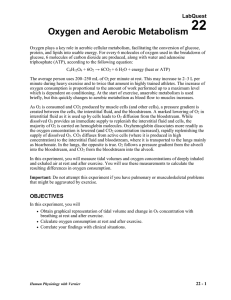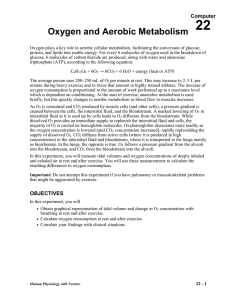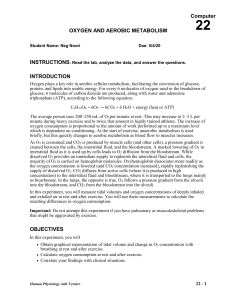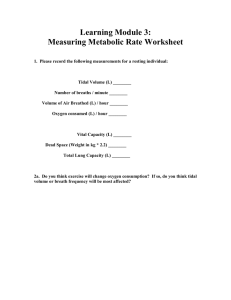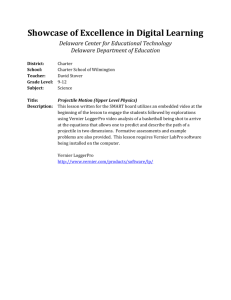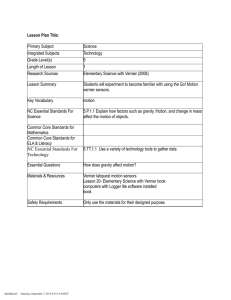22 Oxygen and Aerobic Metabolism Computer
advertisement
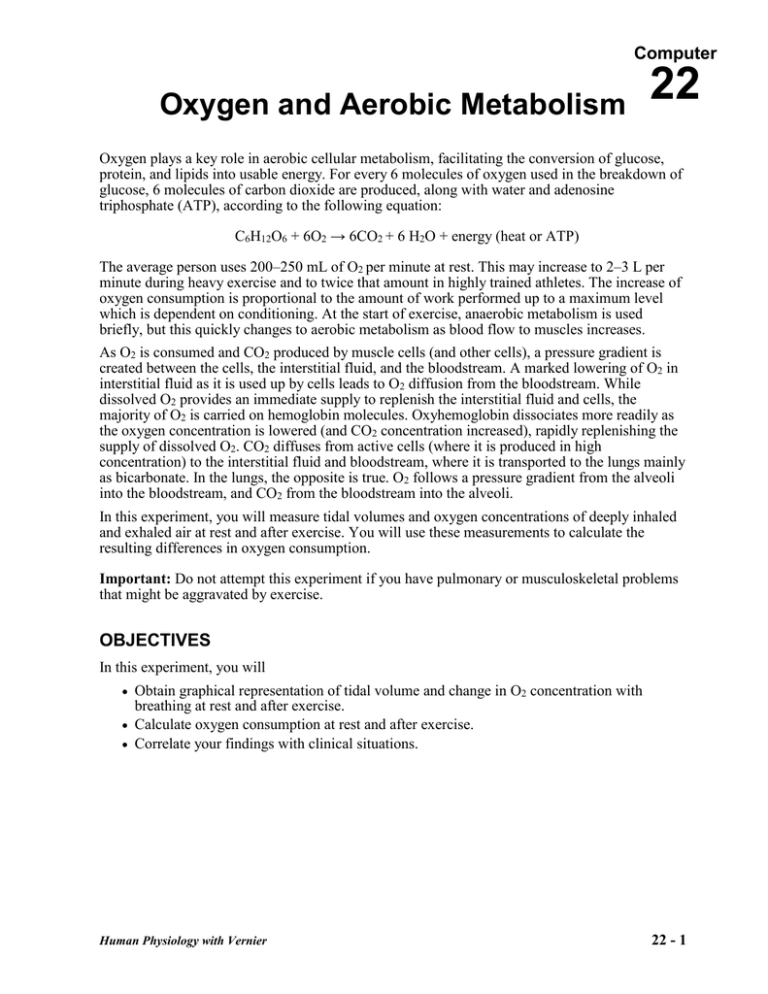
Computer Oxygen and Aerobic Metabolism 22 Oxygen plays a key role in aerobic cellular metabolism, facilitating the conversion of glucose, protein, and lipids into usable energy. For every 6 molecules of oxygen used in the breakdown of glucose, 6 molecules of carbon dioxide are produced, along with water and adenosine triphosphate (ATP), according to the following equation: C6H12O6 + 6O2 → 6CO2 + 6 H2O + energy (heat or ATP) The average person uses 200–250 mL of O2 per minute at rest. This may increase to 2–3 L per minute during heavy exercise and to twice that amount in highly trained athletes. The increase of oxygen consumption is proportional to the amount of work performed up to a maximum level which is dependent on conditioning. At the start of exercise, anaerobic metabolism is used briefly, but this quickly changes to aerobic metabolism as blood flow to muscles increases. As O2 is consumed and CO2 produced by muscle cells (and other cells), a pressure gradient is created between the cells, the interstitial fluid, and the bloodstream. A marked lowering of O2 in interstitial fluid as it is used up by cells leads to O2 diffusion from the bloodstream. While dissolved O2 provides an immediate supply to replenish the interstitial fluid and cells, the majority of O2 is carried on hemoglobin molecules. Oxyhemoglobin dissociates more readily as the oxygen concentration is lowered (and CO2 concentration increased), rapidly replenishing the supply of dissolved O2. CO2 diffuses from active cells (where it is produced in high concentration) to the interstitial fluid and bloodstream, where it is transported to the lungs mainly as bicarbonate. In the lungs, the opposite is true. O2 follows a pressure gradient from the alveoli into the bloodstream, and CO2 from the bloodstream into the alveoli. In this experiment, you will measure tidal volumes and oxygen concentrations of deeply inhaled and exhaled air at rest and after exercise. You will use these measurements to calculate the resulting differences in oxygen consumption. Important: Do not attempt this experiment if you have pulmonary or musculoskeletal problems that might be aggravated by exercise. OBJECTIVES In this experiment, you will Obtain graphical representation of tidal volume and change in O2 concentration with breathing at rest and after exercise. Calculate oxygen consumption at rest and after exercise. Correlate your findings with clinical situations. Human Physiology with Vernier 22 - 1 Computer 22 MATERIALS computer Vernier computer interface Logger Pro Vernier Spirometer Vernier O2 Sensor Vernier CO2-O2 Tee disposable bacterial filter nose clip 4 cm (¾ in.) PVC pipe PROCEDURE Part I Oxygen utilization at rest 1. Assemble the apparatus (see Figure 1). a. Insert the PVC pipe into the larger end of the CO2-O2 Tee. b. Attach the smaller diameter side of the bacterial filter to the free end of the PVC pipe. Caution: Do not puncture the filter material inside the bacterial filter. c. Identify the side of the Spirometer head marked “Inlet” and insert it into the free end of the bacterial filter (the larger diameter side). d. Insert the O2 Gas Sensor into the vertical opening of the CO2-O2 Tee. Figure 1 2. Connect the Spirometer and the O2 Sensor to the Vernier computer interface. Open the file “22 Aerobic Metabolism” from the Human Physiology with Vernier folder. 3. Hold the apparatus in one or both hands. Brace your arm(s) against a solid surface, such as a table, and click . Check Spirometer in the pop-up box that appears. Do not zero the O2 Sensor. Note: The Spirometer must be held straight up and down during data collection (see Figure 1). 4. Collect inhalation and exhalation data. a. Put on the nose clip. b. Click to begin data collection. c. Taking deep breaths, begin data collection with an inhalation and continue to breathe in and out. Each respiratory cycle should last 4–6 s (2–3 s per inhalation and 2–3 s per exhalation). Continue breathing in this fashion for the duration of the experiment. Data collection will continue for 40 s. 5. Click the Next Page button, , to see the volume data. If the baseline on the top graph has drifted, use the Baseline Adjustment feature to bring the baseline volumes closer to zero, as in Figure 2. 22 - 2 Figure 2 Human Physiology with Vernier Oxygen and Aerobic Metabolism 6. Place the cursor on the second peak of the volume graph. Click and drag down to the valley that follows it. Enter the y value displayed in the lower left corner of the graph to the nearest 0.1 L as Breath 1 Pre-exercise Tidal Volume in Table 1. 7. Repeat Step 6 for a total of 3 breaths, entering the y values for each breath in Table 1. 8. Place the cursor on the second peak of the oxygen gas vs. time graph. Click and drag down to the valley that follows it. Enter the y value displayed in the lower left corner of the graph to the nearest 0.01 % as Pre-exercise ∆O2 Concentration in Table 1. 9. Repeat Step 8 for a total of 3 breaths, entering the y values for each breath in Table 1. Part II Oxygen utilization during exercise 10. Clear your data by choosing Clear All Data from the Data menu. Return to Page 1. 11. Begin running in place for 2 minutes, moving arms as well as legs. 12. At the end of two minutes, pick up the apparatus in one or both hands. Brace your arm(s) against a solid surface, such as a table, and click . Check Spirometer in the pop-up box that appears. Do not zero the O2 Sensor. Note: The Spirometer must be held straight up and down during data collection (see Figure 1). 13. Collect inhalation and exhalation data. a. Put on the nose clip. b. Click to begin data collection. c. Taking deep breaths, begin data collection with an inhalation and continue to breathe in and out. Each respiratory cycle should last 4–6 s (2–3 s per inhalation and 2–3 s per exhalation). Continue breathing in this fashion for the duration of the experiment. Data collection will continue for 40 s. 14. Click the Next Page button, , to see the volume data. If the baseline on the top graph has drifted, use the Baseline Adjustment feature to bring the baseline volumes closer to zero, as in Figure 2. 15. Place the cursor on the second peak of the volume vs. time graph. Click and drag down to the valley that follows it. Enter the y value displayed in the lower left corner of the graph to the nearest 0.1 L as Breath 1 Post-exercise Tidal Volume in Table 1. 16. Repeat Step 15 for a total of 3 breaths, entering the y values for each breath in Table 1. 17. Place the cursor on the second peak of the Oxygen Gas vs. Time graph. Click and drag down to the valley that follows it. Enter the y value displayed in the lower left corner of the graph to the nearest 0.01% as Post-exercise ∆O2 Concentration in Table 1. 18. Repeat Step 17 for a total of 3 breaths, entering the y values for each breath in Table 1. 19. Compute the average value for each of the parameters measured and enter those values in Table 1. Human Physiology with Vernier 22 - 3 Computer 22 DATA Table 1 Tidal volume (L) Breath Pre-exercise Post-exercise ∆O2 Concentration (%) Pre-exercise Post-exercise 1 2 3 4 Average DATA ANALYSIS 1. Compare the tidal volumes of the 4 breaths you analyzed both at rest and post-exercise. Is it important for this experiment that resting and post-exercise tidal volumes be similar? 2. Inhaled oxygen should have the same concentration at rest and post-exercise (approximately 21%), yet the peak oxygen concentration values in the post-exercise run never achieve this value. What aspect of the experimental design accounts for this finding? 3. Use the average values for Tidal Volume and ∆O2 Concentration (%) from Table 1 to calculate the average O2 consumed pre- and post-exercise per breath and over the combined 4 breaths: ∆O2 Concentration (%) Tidal Volume (L) = O2 consumed per breath O2 consumed per breath 4 breaths = O2 consumed over that time interval 4. CO2 was not measured. What would you expect the volume of exhaled CO2 to be in this experiment at rest and after exercise? 22 - 4 Human Physiology with Vernier Oxygen and Aerobic Metabolism EXTENSIONS 1. Oxygen consumption with exercise is directly proportional to the muscle mass being used. Demonstrate this principle by performing this experiment exercising with your legs only and/or with your arms only. 2. Perform this experiment after exercising for varying lengths of time (1 minute or 5 minutes). Human Physiology with Vernier 22 - 5
